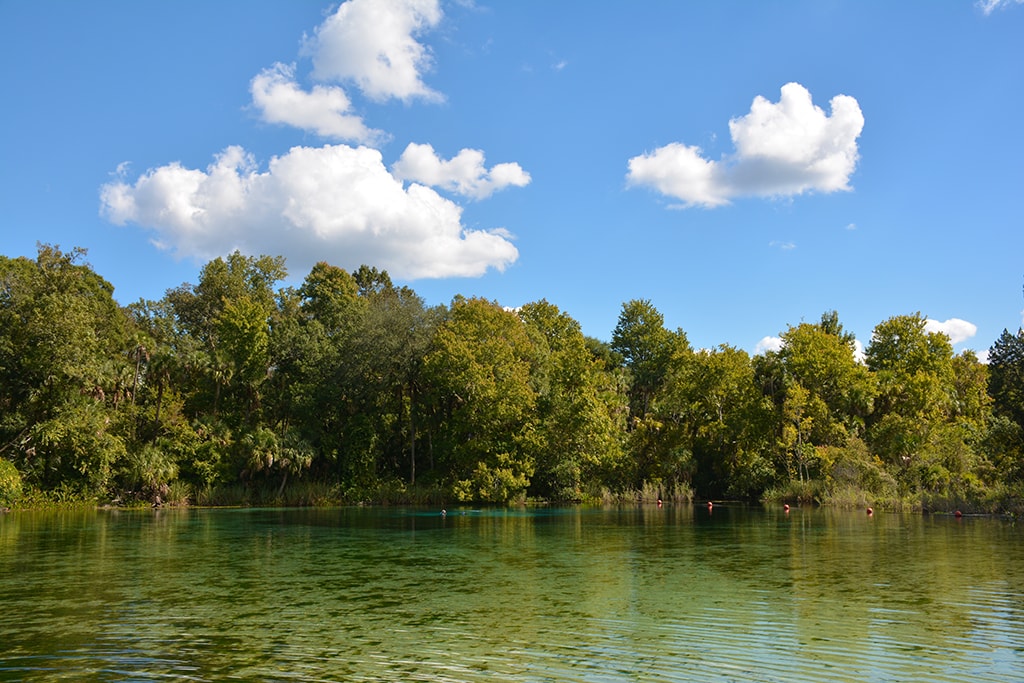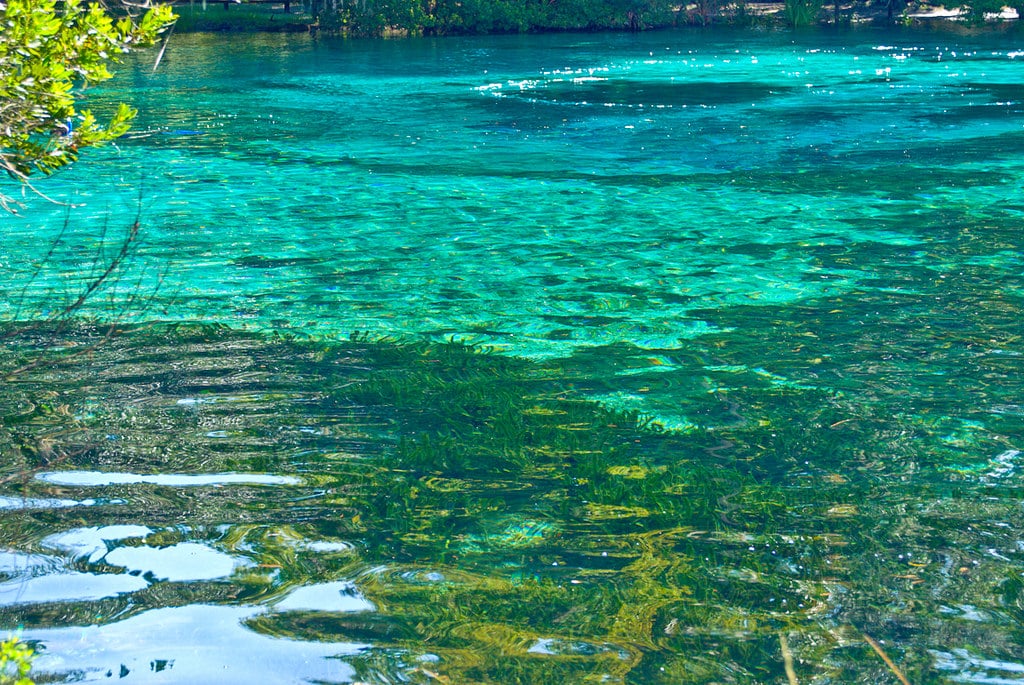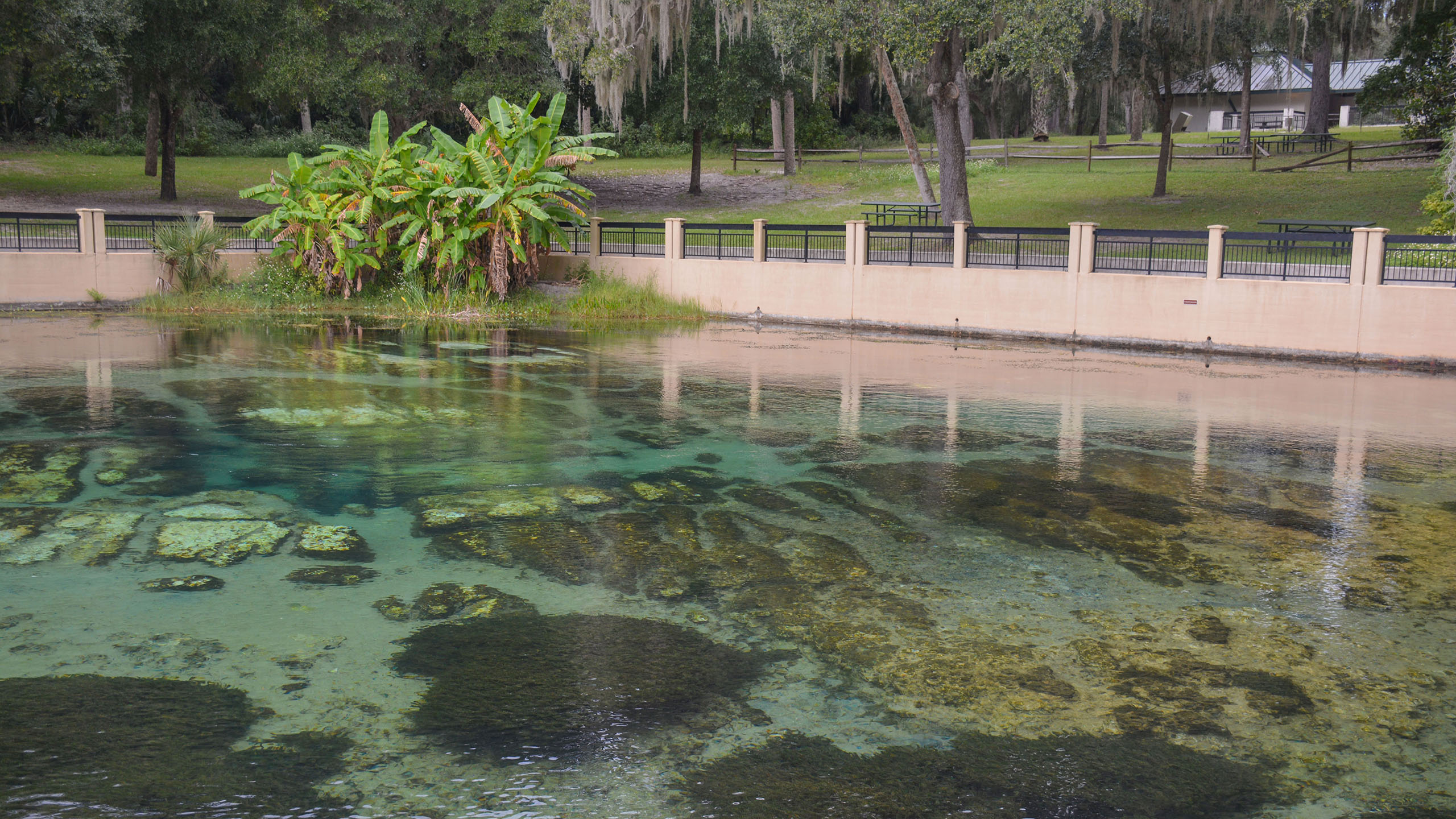72.2 miles. If there is one place that is the heart of the Florida Trail, it is the Ocala section, where the trail first began.
In October 1966, Florida Trail Association founder Jim Kern and a handful of hikers with a dream painted the trail’s first blaze at the beginning of this segment at Clearwater Lake.
They developed the state’s first 26 mile trail, suitable for backpacking. From that grew 72 miles of unbroken backcountry hiking through sandhills, prairies, pine flatwoods, and the beautiful Big Scrub.
The Ocala section is now a prime destination for backpackers who want to spend a week on the Florida Trail. The footpath is well maintained and well worn, and signage at road crossings helps you figure out exactly where you are.

Our Florida Trail Books & Guides





Disclosure: As authors and affiliates, we receive earnings when you buy these through our links. This helps us provide public information on this website.
Trip Planning
Camping
A bear bag or bear canister is required for backpackers in the Ocala National Forest. Be absolutely sure to properly protect your food from bears when camping here. There have been many bear incidents centered around Hidden Pond.
The Florida Trail Association has partnered with the US Forest Service and Buck N’ Bass Sports Center in Salt Springs to offer free loaner bear canisters: a 10 liter Backpackers Cache 812 model. Deposit required. Reserve at 352-685-0200.
Random camping is permitted along the Florida Trail in the Ocala National Forest except during deer hunting season in the fall. Then, it’s necessary to pay for a spot in one of the campgrounds.
You can also use the Grassy Pond designated campsite, or random camp anywhere within Juniper Prairie Wilderness since hunting is not allowed there.
Dogs
This is an excellent section of the Florida Trail for hiking and backpacking with dogs, since the trail is largely dry.
Dogs are not allowed in the recreation areas at the springs, but they are permitted to be in the campgrounds at those recreation areas.
Wildlife
Bears are frequently seen along this portion of the trail. Keep a safe distance away if you spot one. Deer and wild turkey are also common, as well as sandhill cranes in the open prairies.
We’ve seen otters in prairie ponds. A colony of endangered red-cockaded woodpeckers are near the trail close to Salt Springs.
Water
When other parts of the Florida Trail are under water, the Ocala is not. This is a high and dry section of trail, which also means that water sources are very limited in certain areas, particularly north of The 88 Store.
Hunting Season
Wear a bright orange shirt or vest during hunting seasons in the Ocala National Forest. Check the FWC website for hunting season dates.
During general gun (deer) season, backpackers must use designated campsites and recreation areas (fee camping). Random camping is permitted at all other times.
Resupply
Resupply for long distance hikers isn’t easy through this section, so be sure to stock up in Paisley if northbound, or in Palatka if southbound.
The 88 Store has some basic munchies and ice cream, but not enough for a resupply, so the only viable resupply is at Salt Springs, 2.5 miles off the main trail via a blue blaze.’
Parking and Shuttle
Vandalism has been reported at trailheads to vehicles left overnight. Leave your car behind the gates of a recreation area or campground than at a roadside crossing or trailhead. They will charge a fee. Call ahead to confirm costs.
If you need assistance with a shuttle, join the Florida Trail Hikers Facebook group and ask for assistance. There are a number of volunteers in the area who can help. Be sure to compensate them for their gas and time.
Safety
During the winter months, the “Rainbow People” migrate into the forest and set up primitive camps, often along the Florida Trail. These folks live a nomadic lifestyle much like followers of the Grateful Dead used to do.
Use your smarts when you meet non-hikers. If the situation is uncomfortable, keep moving.
The muffled thunder you sometimes hear are when bombs are being dropped on the Pinecastle Bombing Range south of Juniper Springs.
This has been going on since World War II to train military pilots. Low-flying bombers may also startle you on weekdays near Farles Prairie and Juniper Springs.
Trail Map

Mileages
Important landmarks starting with mile 0 at Clearwater Lake trailhead and ending at mile 72.2 at St. Johns South adjoining Buckman Lock.
0.0 – Clearwater Lake trailhead (campground+ $ 0.2E)
10.1 – Alexander Springs Recreation Area+ $ 0.5W
13.6 – SR 19 trailhead
18.2 – Farles Prairie trailhead $
27.9 – Juniper Springs Recreation Area+ $ 0.5E
36.7 – Pat’s Island trailhead
38.5 – Hopkins Prairie trailhead (campground+ $ 0.1W)
45.2 – Salt Springs trailhead 2.9E
52.7 – 88 Store
53.2 – CR 316 parking
59.1 – Lake Delancy West trailhead and campground+ $ 0.2E
65.9 – Rodman trailhead
66.6 – Rodman Recreation Area
67.7 – Rodman Campground+ $ 0.2W
72.1 – St. Johns South campground+
$ fee charged. + designated campsite. * permit needed.
Trail Segments
Details about all segments of the Florida Trail in this section are in The Florida Trail Guide and app. Each of these are described from the perspective of a day hiker, noting landmarks, water, and campsites along the way. Not all are oriented from south to north, but this is the order they are in northbound.
 Florida Trail, Clearwater Lake to Alexander Springs 10.5 miles. Hike the original miles blazed by Florida Trail Association trailblazers in 1966 along one of the most beautiful sections of the Florida Trail in the Ocala National Forest.
Florida Trail, Clearwater Lake to Alexander Springs 10.5 miles. Hike the original miles blazed by Florida Trail Association trailblazers in 1966 along one of the most beautiful sections of the Florida Trail in the Ocala National Forest. Florida Trail, Alexander Springs to Farles Prairie 8.6 miles. Dive deep into the world's largest sand pine scrub forest on this hike through the Big Scrub.
Florida Trail, Alexander Springs to Farles Prairie 8.6 miles. Dive deep into the world's largest sand pine scrub forest on this hike through the Big Scrub. Florida Trail, Farles Prairie to Juniper Springs 9.7 miles. Follow a ribbon of tall grasses and lily-dotted ponds along Farles Prairie before trekking miles through classic sand pine scrub to the Juniper Prairie Wilderness.
Florida Trail, Farles Prairie to Juniper Springs 9.7 miles. Follow a ribbon of tall grasses and lily-dotted ponds along Farles Prairie before trekking miles through classic sand pine scrub to the Juniper Prairie Wilderness. Florida Trail, Juniper Springs to Hopkins Prairie 10.6 miles. Marvel at a mosaic of ancient scrub forest, vast prairies, and pine islands while crossing the Juniper Prairie Wilderness north of Juniper Springs.
Florida Trail, Juniper Springs to Hopkins Prairie 10.6 miles. Marvel at a mosaic of ancient scrub forest, vast prairies, and pine islands while crossing the Juniper Prairie Wilderness north of Juniper Springs. Florida Trail, Hopkins Prairie to Salt Springs 9.6 miles. Sweeping along the shoreline of one of the largest prairies in the Ocala National Forest, this section of the Florida Trail lingers on prairie panoramas.
Florida Trail, Hopkins Prairie to Salt Springs 9.6 miles. Sweeping along the shoreline of one of the largest prairies in the Ocala National Forest, this section of the Florida Trail lingers on prairie panoramas. Florida Trail, Salt Springs to Kerr Island 10.4 miles. Crossing a patchwork of scrub ridges and longleaf pine islands, the Florida Trail makes its way southwest of Salt Springs around Lake Kerr to The 88 Store.
Florida Trail, Salt Springs to Kerr Island 10.4 miles. Crossing a patchwork of scrub ridges and longleaf pine islands, the Florida Trail makes its way southwest of Salt Springs around Lake Kerr to The 88 Store.  Florida Trail, Kerr Island to Lake Delancy 6.4 miles. Across a mosaic of sandhills and scrub, expect black bear and scrub-jay sightings on this Florida Trail segment north of Salt Springs.
Florida Trail, Kerr Island to Lake Delancy 6.4 miles. Across a mosaic of sandhills and scrub, expect black bear and scrub-jay sightings on this Florida Trail segment north of Salt Springs. Florida Trail, Lake Delancy to Rodman 6.7 miles. Experience a sense of perspective on a piece of the Florida Trail traversing rolling hills topped with a majestic forest of longleaf pines.
Florida Trail, Lake Delancy to Rodman 6.7 miles. Experience a sense of perspective on a piece of the Florida Trail traversing rolling hills topped with a majestic forest of longleaf pines. Florida Trail, Rodman to Buckman Lock 6.5 miles. Providing views across the Cross Florida Barge Canal from a high levee, the Florida Trail between Rodman and Buckman Lock mainly follows the Cross Florida Greenway.
Florida Trail, Rodman to Buckman Lock 6.5 miles. Providing views across the Cross Florida Barge Canal from a high levee, the Florida Trail between Rodman and Buckman Lock mainly follows the Cross Florida Greenway.Public Lands
The public lands this section of the Florida Trail crosses.
 Ocala National Forest Established in 1908 as the first National Forest east of the Mississippi, the Ocala National Forest is a mecca for hikers and campers, and the birthplace of the Florida Trail.
Ocala National Forest Established in 1908 as the first National Forest east of the Mississippi, the Ocala National Forest is a mecca for hikers and campers, and the birthplace of the Florida Trail. Cross Florida Greenway Spanning 110 miles between the St. Johns River near Palatka and the Gulf of Mexico, the Marjorie Harris Carr Cross Florida Greenway is a mile-wide recreational corridor with trails, campground, and boating access.
Cross Florida Greenway Spanning 110 miles between the St. Johns River near Palatka and the Gulf of Mexico, the Marjorie Harris Carr Cross Florida Greenway is a mile-wide recreational corridor with trails, campground, and boating access.Side Trails
Trails that interconnect with and sometimes share a portion of the Florida Trail route.
 The Yearling Trail On Pat's Island, discover the landscape and the history that inspired Marjorie Kinnan Rawlings to write her Pulitzer Prize-winning novel The Yearling in 1938.
The Yearling Trail On Pat's Island, discover the landscape and the history that inspired Marjorie Kinnan Rawlings to write her Pulitzer Prize-winning novel The Yearling in 1938. Salt Springs Loop Savor the beauty of the Big Scrub and habitats along crystalline Salt Springs Run on this easy loop on the outskirts of Salt Springs.
Salt Springs Loop Savor the beauty of the Big Scrub and habitats along crystalline Salt Springs Run on this easy loop on the outskirts of Salt Springs.Recreation Areas
Blue blazed connectors lead to both campgrounds and day use areas at beautiful first-magnitude springs for swimming.
 Alexander Springs Surrounding one of Florida's most picturesque first magnitude springs, Alexander Springs is a prime destination for a summer swim or snorkel.
Alexander Springs Surrounding one of Florida's most picturesque first magnitude springs, Alexander Springs is a prime destination for a summer swim or snorkel. Clearwater Lake Recreation Area With a campground and lakeside day use area at the southeast corner of the Ocala National Forest, Clearwater Lake Recreation Area offers an easy loop hike and access to the Florida Trail.
Clearwater Lake Recreation Area With a campground and lakeside day use area at the southeast corner of the Ocala National Forest, Clearwater Lake Recreation Area offers an easy loop hike and access to the Florida Trail. Silver Glen Springs With a strong aquamarine hue accented by refracted rainbows as sunlight plays across the ripples on its sandy bottom, Silver Glen Springs is a first-magnitude spring in the Ocala National Forest.
Silver Glen Springs With a strong aquamarine hue accented by refracted rainbows as sunlight plays across the ripples on its sandy bottom, Silver Glen Springs is a first-magnitude spring in the Ocala National Forest. Juniper Springs Experience crystalline waters emerging from the midst of the world’s largest scrub forest in a subtropical forest at Juniper Springs in the Ocala National Forest.
Juniper Springs Experience crystalline waters emerging from the midst of the world’s largest scrub forest in a subtropical forest at Juniper Springs in the Ocala National Forest. Salt Springs Recreation Area See the beauty of William Bartram's "amazing crystal fountain" as you gaze into the depths of this rocky spring in the Ocala National Forest
Salt Springs Recreation Area See the beauty of William Bartram's "amazing crystal fountain" as you gaze into the depths of this rocky spring in the Ocala National ForestConnections
These sections of the Florida Trail adjoin the Ocala section to its north, south, and west.
 Florida Trail, Northeast Florida Connecting public lands on this 123 mile stretch, the Florida Trail walks into the past through farms and timberlands between Palatka and Osceola National Forest.
Florida Trail, Northeast Florida Connecting public lands on this 123 mile stretch, the Florida Trail walks into the past through farms and timberlands between Palatka and Osceola National Forest. Florida Trail, Orlando Between the prairies of Osceola County and the Ocala National Forest, this 150 mile section of the Florida Trail slips through suburbs of the Orlando metro.
Florida Trail, Orlando Between the prairies of Osceola County and the Ocala National Forest, this 150 mile section of the Florida Trail slips through suburbs of the Orlando metro. Florida Trail, Western Corridor Linking Withlacoochee State Forest and the Cross Florida Greenway, the 241 mile Western Corridor of the Florida Trail accesses wild spaces between Tampa and Ocala.
Florida Trail, Western Corridor Linking Withlacoochee State Forest and the Cross Florida Greenway, the 241 mile Western Corridor of the Florida Trail accesses wild spaces between Tampa and Ocala. Recent Articles
 National Forests in Florida Implement New Fees (7/24/2019) Effective July 26, 2019, fees go up at many National Forest campgrounds, boat ramps, and recreation areas
National Forests in Florida Implement New Fees (7/24/2019) Effective July 26, 2019, fees go up at many National Forest campgrounds, boat ramps, and recreation areas Mountain Biking and the Florida Trail (3/3/2016) It's Florida Biking Month! Which makes it a good time to talk about bikes and the Florida Trail, and how to ride your bike to, but not on, our statewide National Scenic Trail when it's in the woods.
Mountain Biking and the Florida Trail (3/3/2016) It's Florida Biking Month! Which makes it a good time to talk about bikes and the Florida Trail, and how to ride your bike to, but not on, our statewide National Scenic Trail when it's in the woods.- Disappearing Creek Loop - April 9, 2025
- Tippecanoe Environmental Park - April 3, 2025
- Cedar Point Environmental Park - April 2, 2025
